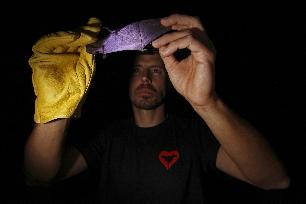The Roques Blanques Cemetery, a pioneering space in Spain for bat studies

Papiol (Barcelona), October 25, 2012
The Regional Cemetery of Roques Blanques, located in Papiol (Barcelona), has launched the first permanent bat ultrasound monitoring station in Spain. This installation will provide continuous information on the activity of these animals in the area, which are currently threatened in most of their habitats. The permanent station will gather data on bat species richness and their activities, including hunting, social interactions, and migration, among others.
This initiative is part of Roques Blanques’ policy to protect native flora and fauna, as acknowledged by Joan Ventura, director of the Cemetery Division at Serveis Funeraris Integrals (SFI), the managing company of this public cemetery: "The characteristics of Roques Blanques make it a unique space, as its 50 hectares are fully integrated into the natural environment of the Collserola Natural Park." Roques Blanques was the first cemetery in Spain and the third in Europe to achieve the European EMAS certification, the strictest environmental certification.
The bat monitoring project is unique and pioneering in Spain. It is led by biologist Carles Flaquer, coordinator of the Bat Area at the Granollers Museum of Natural Sciences (MCNG), in collaboration with Xavier Puig from the Galanthus Association and the technology company Advancare. The initiative complements studies conducted over the years for the Consortium of the Collserola Natural Park and is part of a campaign that will continue in 2013 across Catalonia. "The placement of the first fixed station at Roques Blanques Cemetery is ideal because we can position it in a natural setting, amidst the forest, within reach of technicians, and at the same time, it will be protected by the cemetery's grounds," explains Carles Flaquer. Through this initiative, the Bat Area of the MCNG aims to create synergies between technology and biology, with the goal of contributing to scientific knowledge. Specifically, data will be obtained on bats under various climatic conditions and throughout the year, with the aim of observing relationships between environmental factors and the activity of these animals. In this regard, the Catalan Climate Change Office of the Generalitat and the MCNG have long been researching climate-activity relationships to determine the suitability of bats as indicators of climate change impacts in Catalonia.
Bats: Excellent Bioindicators
"There are several experiences that demonstrate that bats are excellent indicators of habitat quality and are sensitive to changes caused by humans in ecosystems," explains biologist Carles Flaquer. Their metabolism and fat storage capacity make bats more precise indicators of pollutant accumulation than birds or insects. Currently, they are heavily threatened in most areas of the planet due to human activity.
According to Joan Ventura, director of Cemeteries at SFI, "Through this project, we contribute to the knowledge and protection of these animals, but also to combat the tiger mosquito, which is prevalent in cemeteries, as bats are voracious insectivores that consume 100% of their body weight in insects each night, playing a crucial role in controlling insect populations."
Bats, or chiropterans, include a very extensive number of species (more than 1,200 on Earth). In Catalonia, there are 30 species of bats, and up to 34 are found throughout Spain, all insectivorous, distributed across various ecosystems and, in some cases, with clear specialization for specific habitats. They are the most diverse group of mammals in Spain.
Roques Blanques: Committed to the Environment
With an area of 50 hectares and funeral buildings that blend perfectly into the natural surroundings of the Collserola mountain range, Roques Blanques has been characterized since its construction in 1984 by the protection of native flora and fauna (such as amphibians, hedgehogs, and common squirrels), energy resource conservation (reducing water and paper consumption), pollution prevention, and minimizing environmental impacts (waste recycling, control of atmospheric emissions from crematoria, promoting the use of controlled logging wood). In this regard, cemetery visitors are encouraged to use natural flowers that can be recycled as fertilizer. The cemetery also offers innovative ecological alternatives to address the growing need for cremation, such as the Forest of Calm and the Family Tree, burial options that simultaneously promote reforestation of the Collserola forest by planting a tree—oak, cork oak, or pine—over one or several biodegradable urns; or the Rest Garden, a space for ashes that allows for the control and management of non-ecological urns, preventing their abandonment in natural spaces. The cemetery's design, fully integrated into nature, is the work of architects Batlle and Roig. The project was a finalist in the FAD Architecture Awards and is the only one of its kind in Spain.